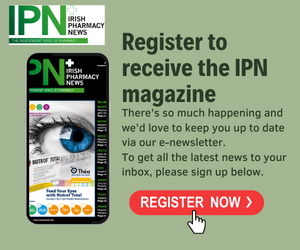Older adults aged over 60 years account for more than 1 million people in Ireland, equating to 1 in 4 of the adult population.1 Older adults represent a large proportion of pharmacy customers, in particular as increasing age is associated with increasing medical conditions and drug treatments.2, 3 Common medical conditions include hypertension, hypercholesterolemia, diabetes mellitus, cardiovascular disease, chronic lung disease, arthritis or chronic pain.3

Optimisation of medicines is important for many reasons. Medications have potential side-effects and this risk can be increased in older adults for a multitude of reasons including altered pharmacodynamics/ pharmacokinetics, visual or hearing impairments, cognitive impairment and polypharmacy.
Polypharmacy is described as the prescription of 5 or more regular medications. Polypharmacy is associated with an increased risk of adverse drug reactions, potentially inappropriate medicines and non-adherence.2 Polypharmacy is reported in 33% of older adults and is more likely in adults with lower educational level, poor self-rated health, medical card eligibility and greater morbidity. The Irish Longitudinal Study on Ageing (TILDA) report in 2012 showed that polypharmacy accounts for “over half of the annual costs of prescribing to the entire population over 50 years.”2 Patients with polypharmacy also represent “51% of inpatient hospital visits, 55% of outpatient hospital visits and 41% of GP visits.”2
How do we tackle medication management to support older adults living in Ireland? There are a number of simple measures that can be considered:
Regular Medication Reviews
The ‘Supporting Prescribing in Older Adults with Multimorbidity in Irish Primary Care’ (SPPiRE) trial published in January 2022 demonstrated that GPled medication review led to a small but significant reduction in the quantity of prescribed medications.4 One limitation, however, is the significant time constraints under which GPs operate. Therefore the responsibility should be spread across the healthcare system, with opportunities to review medications at each patient contact. Medication reviews can be undertaken in community, outpatient or inpatient settings by pharmacists, doctors and advanced nurse practitioners. Review tools that can be utilised include the Anticholinergic Burden Scale,5 Medication Appropriateness Index6 and STOPP-START criteria.7
Education
International research has shown improved health outcomes and medication adherence in patients who are well informed.8 Ideally patients and/or caregivers should be educated about the indications, benefits and risks of prescribed medications. Instructions should be clear, simple and if necessary be provided in written format to optimise understanding and promote health literacy. If required translators or translations should be used to optimise communication.
Package Leaflets can be informative however they can be written in small print with detailed, elaborate instructions and extensive precautions that may be difficult for the consumer to understand. More user-friendly alternatives can be administered by the prescribers or dispensers. These include patient information leaflets, alert cards and reminder cards9 that should be easy to read and in large print without the use of complex language or medical jargon. For example, the HSE website provides clear patient information leaflets on common medications.10 Reminder systems to augment education and safe medication use include blister packs, medication charts and smartphone apps.11
National Prescribing System
A national prescribing system that could be made accessible to both community and pharmacist healthcare workers would optimise medication safety and adherence. It could also reduce the risk of medication errors including omissions. This would allow for joined-up care for our older adults as they navigate the healthcare system. It could also provide an easily accessible reference system for medication prices, including the availability of generic options.
In conclusion, older adults account for a large proportion of healthcare and medication users. Optimisation of medications through simple measures such as medication reviews and education can improve patient outcomes, promote health literacy and reduce the risk of medication adverse events.
References available on request
Read the February Magazine here










